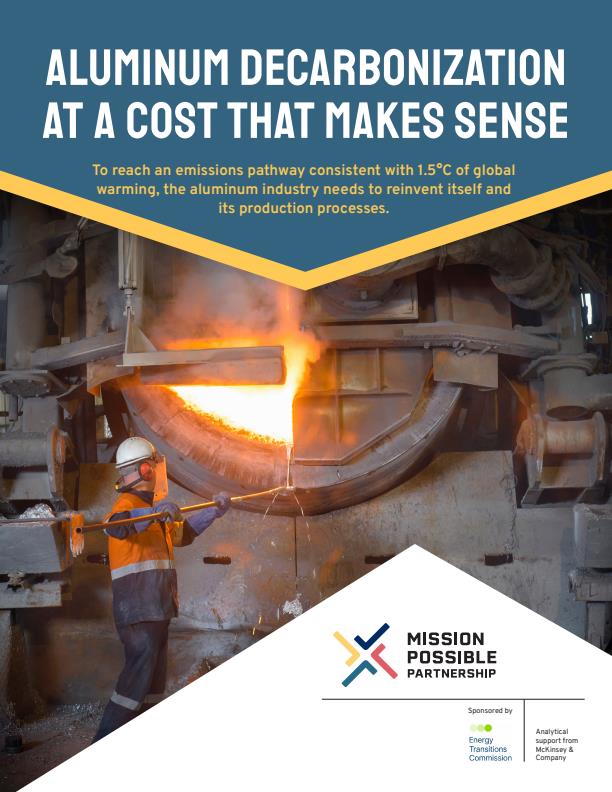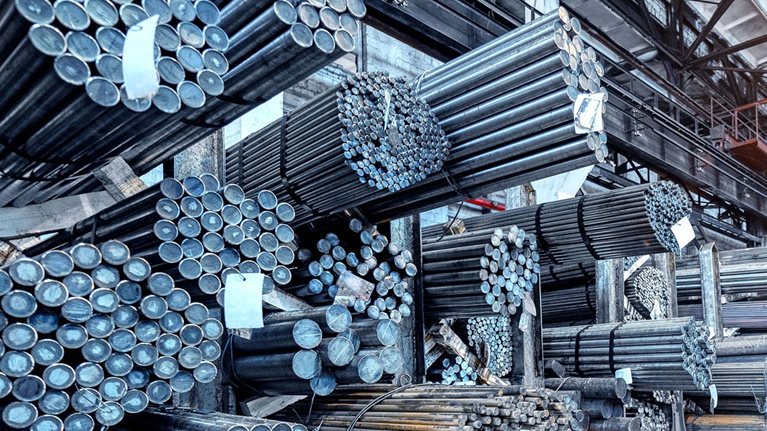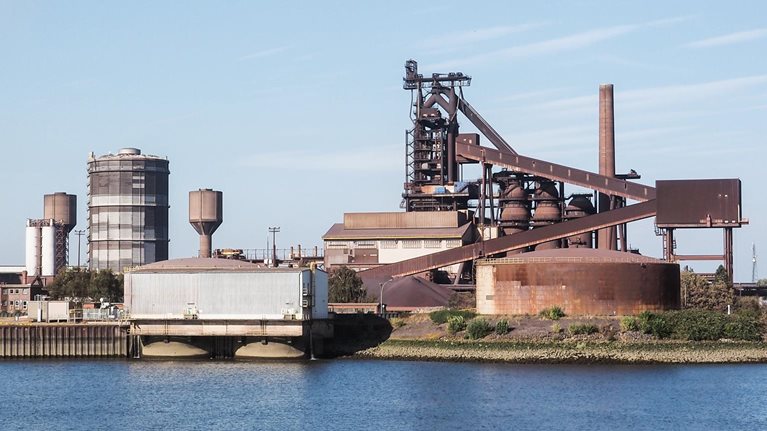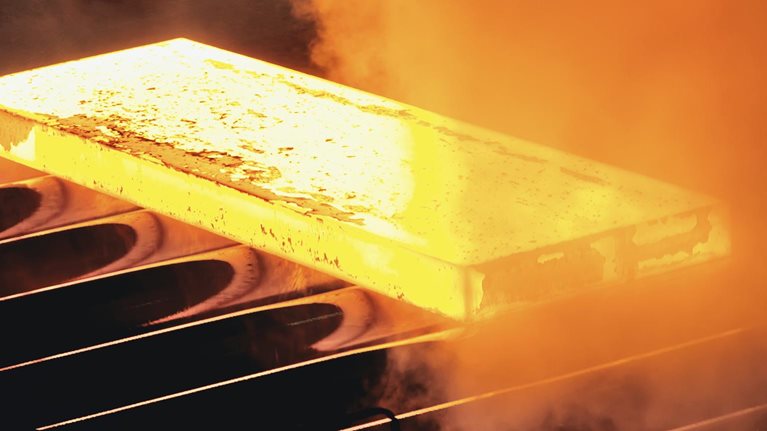Aluminum has an important role to play in global efforts to reduce greenhouse-gas emissions. This element is a critical building block for everything from electric vehicles and energy-efficient buildings to a modernized electrical grid. And unlike other basic materials such as steel and plastic, aluminum can be infinitely recycled with no loss of quality.1 About 75 percent of all the aluminum ever produced is still in use today.2
While the metal itself is sustainable, its production usually is not. Although abundant in the Earth’s soil and rocks, aluminum does not occur in its pure form and has to be extracted from compounds—a complicated process of refining and smelting that requires a large and constant load of electricity. To produce this energy, many countries rely on coal. Globally, about 55 percent of the electricity needed for aluminum smelters comes from coal-fired power plants (with 10 percent from natural-gas plants and 30 percent from hydropower).3 As a result, the aluminum industry is among the highest-emitting sectors in the world, accounting for about 2 percent of global greenhouse-gas (GHG) emissions.4
The challenge of radical decarbonization
To achieve an emissions pathway consistent with 1.5°C of global warming (as envisioned by the Paris Agreement on climate change), the aluminum industry will need to slash emissions dramatically—from around 15.9 metric tons of carbon dioxide equivalent (CO2e) per metric ton of primary aluminum (nonrecycled) today to lower than 0.5 tCO2e/t by 2050, according to the International Aluminium Institute. Progress is already under way. In China, which produces nearly 60 percent of the world’s primary aluminum, the country’s largest producer has shifted much of its capacity to the hydropower-rich Yunnan province.5 Many companies are also exploring green technologies, including carbon capture and storage; inert-anode technology, which avoids the formation of CO2; and mechanical vapor recompression (MVR), which recycles waste heat to improve efficiency. The industry’s current pipeline of green projects, however, is likely not enough to achieve this ambitious 95 percent reduction target.
To accelerate the pace of decarbonization, bold action is required on multiple fronts, as explored in a new report by the Mission Possible Partnership with analytical support from McKinsey. No easy answer exists. Producing greener aluminum isn’t a simple matter of swapping out coal generation with renewable energy. Throughout each stage of aluminum production, large amounts of constant-load energy are required. Although the end goal is to make clean or renewable energy central to the production process, the most cost-efficient and effective way to get there is likely to involve a range of technologies and solutions (see sidebar, “An investment model for change”).
Options for producing greener aluminum
Any effort to produce low-carbon aluminum has to directly address the supply of electricity required for the smelting process, in which aluminum is extracted from its oxide, alumina. Roughly 80 percent of primary aluminum GHG emissions are generated from smelting, of which 81 percent are associated with the electricity used for electrolysis.6 For aluminum smelters that have opted to supply this energy from their own power plants, as opposed to obtaining energy from the grid, solar or wind generation can be a useful addition. But due to their intermittency, these renewable sources won’t be able to fully power the process.
To generate large, stable loads, some producers have turned to hydropower. But this option potentially has limited growth, is regionally specific, and may be impacted by potential droughts. Nuclear energy, in the form of small modular nuclear reactors (SMRs), offers promise but is still at an early stage. For many smelters with their own generation ability, the most realistic short- to medium-term option may be retrofitting coal-fired power plants or natural-gas combined cycle plants with carbon capture utilization and storage (CCUS).
Aluminum smelting operations that get their electricity from the grid have two potential options. One is to enter into virtual power purchase agreements (VPPA) with utilities. These agreements, which allow aluminum producers to claim GHG reductions, could achieve several goals. They could potentially support new renewable-energy projects, help accelerate a utility’s migration to low-carbon electricity, and provide a hedge against future energy price movements. An alternate option is a strategic relocation to regions that already have significant amounts of green electricity.
The process of refining the sedimentary rock bauxite oxide to produce alumina also generates GHG emissions, albeit far fewer than smelting (17 percent of aluminum’s total emissions).7 Decarbonizing this process will mean shifting the fuel source for thermal boilers away from coal and heavy fuel such as diesel and oil. Producers in countries with access to reliable natural gas could switch to natural-gas-fired boilers and calciners, although this option will likely only reduce refining emissions by about one-third.8 More widely applicable alternatives that could reduce nearly all thermal refining emissions are electric boilers powered by either wind or solar,9 hydrogen boilers supplied with green hydrogen, or boilers that employ MVR technology, an energy recovery process that can be used to recycle waste heat.10
How stakeholders can help
One of the challenges to aluminum decarbonization is that the best currently available fossil-fuel-based technology has a net present value greater than the green alternative. Overcoming these economic obstacles and mitigating potential risks will likely require collaborative action among stakeholders. Banks, investors, policy makers, and end customers can each play an important role.
The finance sector. Decarbonization won’t be cheap. Globally and across industries, the net-zero transition is projected to demand average annual spending of $9.2 trillion by 2050.11 Aluminum producers will need to retire fossil-fuel-based production and make new investments in low-carbon alternatives, even though these are likely to have a lower return on capital and entail a certain amount of technology and implementation risk. Financial institutions have the capability to mitigate some of these risks and shift cash flows toward green investments. Given the generally high levels of debt in the aluminum industry, improved interest rates for low-carbon investments and new products such as green loans or bonds used exclusively for climate-friendly projects could be key enablers. Additionally, banks could incorporate climate considerations into their lending decisions, such as those developed by the Center for Climate-Aligned Finance (CAF). Financial partnerships designed to support sustainable investment are already happening, such as the Net-Zero Banking Alliance (NZBA), which brings together banks representing 40 percent of global banking assets.
Governments and policy makers. Government grants to aluminum producers could potentially help offset some of the costs of green investment, while carbon contracts for difference (CCfDs) could bring the operational costs of decarbonized operations in line with those of fossil-fuel-based technology. However, the analysis shows that the greatest impact to the economics of decarbonization could come from carbon pricing, whether through trading schemes or carbon taxes. This could spur investment in green aluminum and enable the economics of the industry’s net-zero transition.
Customers. Aluminum users likely have an important role to play in creating demand and helping shift the industry toward decarbonization. This could include what the report estimates to be a 5 to 10 percent premium for green aluminum or by making firm advance commitments to purchase it. Such offtake agreements could be negotiated before a factory is constructed or begins operating or before major retrofits are undertaken, significantly cutting potential investment risk. For manufacturers that have set decarbonization goals for their sourcing and supply chains, such premiums may be worth paying.
Rising demand for low-carbon products is pushing the aluminum industry away from the carbon-emitting processes that have dominated production for the past 135 years. At the same time, the dynamics of a warming planet are evidence that change needs to happen as fast as possible. To make the green transition a reality, players throughout the aluminum value chain could seize the moment, work together to support a purposeful transition, and recreate the industry for the demands of the coming decades.



